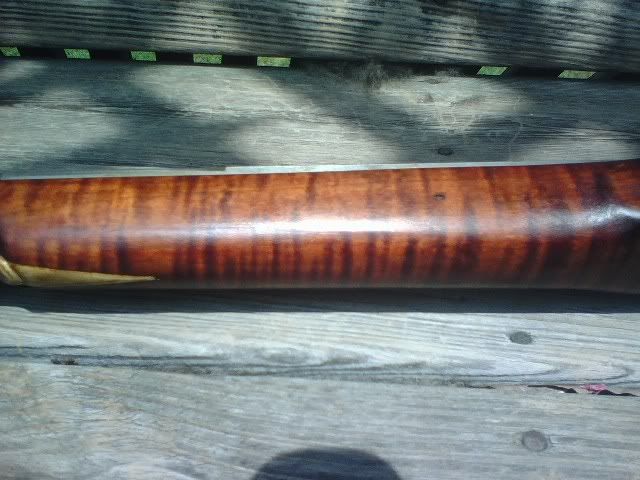Howdy all. I'm getting ready to order the stain for this Leman I'm building. Does anyone have a pic to post of a maple stock stained with LMF cherry? I was just wondering how red it really is. My furniture is all brown iron, so I don't want a brown stain to boot. A little contrast would be nice, and I like the stocks a bit more on the red side. Anyone have a pic? Thanks,Marshal.
You are using an out of date browser. It may not display this or other websites correctly.
You should upgrade or use an alternative browser.
You should upgrade or use an alternative browser.
LMF Cherry stain?
- Thread starter R.J.
- Start date

Help Support Muzzleloading Forum:
This site may earn a commission from merchant affiliate
links, including eBay, Amazon, and others.
- Joined
- Sep 27, 2003
- Messages
- 554
- Reaction score
- 2
I don't know about the Cherry, But this is my TC with Birchwood Casey Rusty Walnut on it. My walnut stock was that yucky light color before I stained it. If you have a test piece you might try some of it. It should look nice on Maple. I thined it down 3W to 1S.

Robert

Robert
Steve Blancard
40 Cal.
- Joined
- Mar 4, 2007
- Messages
- 272
- Reaction score
- 86
The LMF cherry stain is pretty red. I used a coat of it and a coat of their maple stain on my GPR. Then I followed it with flat black spray paint, then removed most of that with steel wool. Finally I finished it with their permalyn sealer and stock finish. This resulted in a warm, used but well cared for look. I've posted a few photos here:
GPR with LMF cherry and maple stain
GPR with LMF cherry and maple stain
That cherry stain is RED. I use it as a base coat and then stain over it with Lancaster maple. There are some pics of one of my rifles in the photo section. The sealer is just that, a sealer, and it does a good job too but IMHO it comes out a little shiny. Just dull it out with steel wool. I like BLO and have used it a lot, however I believe the sealer is a better way to go.
This was with LMF Honey Maple and Tru-Oil finish. The barrel is fully browned. One coat of stain and 4-6 coats of Tru-Oil I think, no base coats or agers. Looking back I probably could have done a little something to bring out what curl there is but it was my first build and I still love it.


it's CRAZY RED. I cannot think of applications where it should be used straight. I don't know what they were thinking when they formulated it.
paulvallandigham
Passed On
- Joined
- Jan 9, 2006
- Messages
- 17,537
- Reaction score
- 94
I used cherry stain- diluted, as its too red!--- to color the coarse "summer growth" grain on a Birch stock. " I covered the stock with stain, then after it dried, I used 4-0 steel wool to remove it from the harder, wider growth rings. Then I used a walnut stain to stain the whole stock. The red stain in the coarse grain POPPED out of the walnut stain, making the thin winter grain easier to see, and look more interesting than what it appears as a plain wood stock.
Using cherry stain on a Maple stock, the same way would help the coarse grain POP out under the maple stain, too.
Try these suggestions from all of us on a scrap piece of wood, before going near the stock. Settle on both the colors, and the technique you will use before doing the stock. Permalyn is a filler, as I read the container. Its not a true finish. Use a hand rubbed oil finish on the stock. If you get a scratch you can fix it with some oil finish rubbed into the scratch, and left to dry, very easily. That is the reason that oils have been used for so long as wood finishes.
Back in the 18th century, lacquers, and varnishes, commonly made for the wooden boat industry, were commonly used to finish gunstocks.( Lacquers were more commonly used by furniture and wooden instrument makers.) Lacquers cloud when exposed for any length of time to UV light. Varnishes also will cloud up eventually, unless some kind of covering coat protects them from the UV rays. Oil finishes may darken over time, and exposure to UV light, but you can clean the oil finish with alcohol, and refinish it with new oil to return it to its original colors.
Using cherry stain on a Maple stock, the same way would help the coarse grain POP out under the maple stain, too.
Try these suggestions from all of us on a scrap piece of wood, before going near the stock. Settle on both the colors, and the technique you will use before doing the stock. Permalyn is a filler, as I read the container. Its not a true finish. Use a hand rubbed oil finish on the stock. If you get a scratch you can fix it with some oil finish rubbed into the scratch, and left to dry, very easily. That is the reason that oils have been used for so long as wood finishes.
Back in the 18th century, lacquers, and varnishes, commonly made for the wooden boat industry, were commonly used to finish gunstocks.( Lacquers were more commonly used by furniture and wooden instrument makers.) Lacquers cloud when exposed for any length of time to UV light. Varnishes also will cloud up eventually, unless some kind of covering coat protects them from the UV rays. Oil finishes may darken over time, and exposure to UV light, but you can clean the oil finish with alcohol, and refinish it with new oil to return it to its original colors.
ricklandes
40 Cal.
- Joined
- Dec 6, 2006
- Messages
- 391
- Reaction score
- 0
I remember reading somewhere that the red was specifically made to match a county or two in PA...
Those counties must have been on fire. :wink:
I've seen some reddish Lehigh guns but never like LMF cherry undiluted. Even cherry stained with lye isn't quite as vivid. I'm not hating on the product but do wish they would give more and better instructions when they sell their stains. Folks may order a red stain thinking it's useable without mixing with other stains, then try it on a gun and nearly ruin it.
I've seen some reddish Lehigh guns but never like LMF cherry undiluted. Even cherry stained with lye isn't quite as vivid. I'm not hating on the product but do wish they would give more and better instructions when they sell their stains. Folks may order a red stain thinking it's useable without mixing with other stains, then try it on a gun and nearly ruin it.
jimmytheshank
40 Cal.
- Joined
- Sep 23, 2007
- Messages
- 472
- Reaction score
- 1
Yeah, I used that stuff on a tomahawk handle for a tommy I put together for my brother. The stuff was almost black as dark a red as that is. I sanded it down and put a coat of LMF Honey maple. The handle came out nice, but it was scary at first.
fort fireman
45 Cal.
- Joined
- Jul 6, 2008
- Messages
- 715
- Reaction score
- 2


This is LMF nut brown that I used on my fowler.I didn't dilute it at all and its alittle redder than I intended. I've never used the cherry but the nut brown is about as redish as I would like to go. Just a pic to help give some ideas if you like a reddish tone. :thumbsup: Andy
That's a great tone and as reddish as I like also.
That is a nice shade of red/brown. I agree that maybe some better pics of the stains on the LMF site would be a big help. I don't know if I will venture to try some as a base coat or not. Kinda scary. I'm tempted,but not all that brave.
Similar threads
- Replies
- 16
- Views
- 2K
- Replies
- 7
- Views
- 310
- Replies
- 3
- Views
- 656
- Replies
- 4
- Views
- 555
- Replies
- 30
- Views
- 1K



